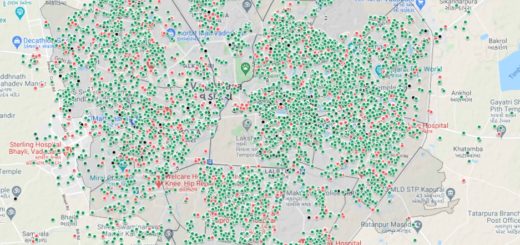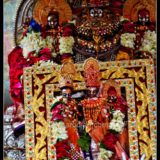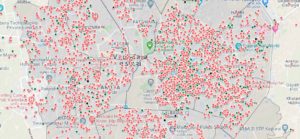How Sir Sayajirao Gaekwad III & Baroda city & state Fight Against Plague in 1897
How Sir Sayajirao Gaekwad III & Baroda city & state Fight Against Plague in 1897?
The Pandemic of Plague reached its peak in India in 1907 and continued thereafter for another 11 years till 1918. The mortality numbers were 5,48,427 deaths between 1898 and 1908. In Baroda State, Plague which first appeared in Navsari had spread over the whole state with varying force by 1899. On its appearance, several measures were adopted by the state including house to hose inspections, inoculation and rigorous inspection of railways travelers, etc.
At that time, Baroda had a population of 1,12,471 according to the census of 1891, of whom 60557 were males and 51914 are females. It has an area of 8 square miles. The Baroda was the fourth important city in the Bombay Presidency coming after Bombay, Ahmedabad, and Poona.
First Case:
The First Imported plague case in Baroda was from Surat, Surnamed KHARWAaffected with plague surreptitiously got entrance into the town on the 10th March 1897 from Surat and died in Lakadpitha, Babajeepura. This case was promptly detected and measures of segregation and disinfection were taken. and no cases were found in this locality after the demise of KHARWA.
After this on 4th April 1897, another case was detected in Jejurkar’s Family, Brahmin by case, and two more cases in the same family and the epidemic spread in the portation round about Jejurker’s house. By 4 to 23 April 1897 total of 7 cases detected.
Any day by day case started an increase in Baroda.
Maharaja Sayajirao III- Invited the famous Russian bacteriologist, Dr. Waldemar Haffkine in the Year 1897.

Dr. Waldemar Haffkine
Waldemar was the first-ever Microbiologist who developed and administered vaccines against Cholera and Plague.
 In this picture, Haffkine can be seen carrying out inoculations in Baroda. Abbas Tyabji was an eminent freedom fighter, the Chief Justice of Baroda State, and was a close friend of the Maharaja, and can be seen on the extreme right of the picture. He was present to inspire the local community to get vaccinated. He also took his daughter Sharifa (seen with Haffkine’s arm around her shoulder) and little cousin Hatim (extreme right) to receive the inoculation. It was in the year 1899 when Dr. Haffkine set up the Haffkine Institute for Training Research and Testing as a plague research laboratory. It is one of the earliest institutes of it’s kind. (Image Source & info: Radhikaraje Gaekwad)
In this picture, Haffkine can be seen carrying out inoculations in Baroda. Abbas Tyabji was an eminent freedom fighter, the Chief Justice of Baroda State, and was a close friend of the Maharaja, and can be seen on the extreme right of the picture. He was present to inspire the local community to get vaccinated. He also took his daughter Sharifa (seen with Haffkine’s arm around her shoulder) and little cousin Hatim (extreme right) to receive the inoculation. It was in the year 1899 when Dr. Haffkine set up the Haffkine Institute for Training Research and Testing as a plague research laboratory. It is one of the earliest institutes of it’s kind. (Image Source & info: Radhikaraje Gaekwad)
Measures were taken by Baroda at that time:
Before the 10th March 1897, when the first imported case from surat was detected, The government had taken the following steps.
– guard the Railyway station to prevent an infected person from getting into the town.
– Medical men were posted to watch all the down passengers trains arriving at the Makapura Vishwamitree and Baroda station.
– Temporary sheds were erected and managed for hospital use to the north of the town for the accommodation of plague-stricken persons suspected to be suffering from the plague, detected on the Railway station.
– The Municipal commissioner was authorized to remove such persons to the isolation hospital under proper precautions.
Formation of Committees:
The Gaikwad Government by an order dated 8th April 1897 for the effectual carrying out of preventive measures, ordered the formation of a committee for the Baroda city and suburbs. The town was divided into 22 circles, a number of the city, Municipal corporation, or a municipal officer, asked to form a committee for that circle. The duties prescribed tot he committee were as under:
1. To undertake house to house inspection for the detection of plague cases.
2. To bring to the notice of the municipal executive filthy and insanitary houses and other buildings which are found to be a source of danger to public health, with a view to their being dealt with under Huzur rules dated 25th February 1897
3. To assist Government officers in removing to plague Hospitals or segregation camps persons whose removal was considered necessary to prevent the spread of the Plague infection.
4. To explain to the people the necessity for adopting preventive measures and to see that the orders issued for the whitewashing and disinfection of unsanitary and plague-stricken houses were properly carried out by their owners.
5. To bring any instance of abuse of power or misconduct on the part of municipal or other servants employed for carrying out preventive measures, to the notice of Government. Each member of the Committee was empowered to enter any dwelling situated within the limits of his Circle for purpose s of inspection between the hours of sun-rise and sun-set after giving one hour notice to the owner or occupiers thereof as required by the rule notified on the 25th February 1897.
Division of the City into Wards
In the middle of January 1898, to make the arrangements for the suppression of plague still more effective, the city was divided into 8 wards, each of the four police Division being sub-divided into two wards. Each ward was provided with the following establishments;-
One Superintendent, three supervisors, three Karkuns, and nine peons. Police establishment was comprising of one Naib Faujdar, one Havaldar, one Jamadar, and ten Constables. In the medical establishment, there was one Medical Officer, one Nurse. Disinfecting and cleaning establishment was comprised of one mistry, one deputy mistry, day laborers according to requirements of each day. Establishment of, general sanitation of ward comprised, one Muccadam, four Construction workers, and ten Safai Sevak.
The above formed a full complement for each ward.
Health Camps
The above measures were soon supplemented by the drastic measure of all plague operations viz, the shifting of the people from the infected area to properly laid out Health Camps outside the City.
A plot of ground on Padra Road, Ajwa Road, and Hami Road was selected by the Government, assisted by the secretary for plague arrangements and Sanitary Commissioner, the District Magistrate, and by the executive engineer, Baroda city.
Maharaja Sayajirao III was graciously pleased to visit the Campsites, soon plotted out by the work of erecting temporary sheds was at once taken in hand by the District magistrate. Each shed was 20’ by 20’ with an enclosure 10×10 for cooking-sufficient space being left between the two rows of sheds. Separate arrangements were made for natural purposes by digging trenches and enclosing them by bamboo taltees. The trenches were filled every day and new ones dug instead. Shopkeepers were induced to open stalls for the sale of provisions and arrangements for the execution of fire and for the lighting of the camps were complete. As soon as the camping out arrangements were completed and people began to be removed the progress of the plague received a check. The Modus Operandi was as follows:-
Each infected locality was marked out commencing with the most infected. The people were first removed by the superintendent to the several wadis or dharma shala which the Government had secured from the Mahajans. Here the people were made to disinfect their persons and belonging and after this was done to the satisfaction of the officer-in-charge of the disinfection, they were marched directly to the health camps by this methods, the health camps were saved from the epidemic, only a few cases being detected, being probably of those who had imbibed the poison into their system previous to their leaving for the health camps.
For each health camp were appointed Superintendent from among the officials of the State, supervisors, karkuns, police guard, municipal fire brigade establishment, and lighting conservancy establishments.
Water pipes were laid on to these camps which were also supplemented by wells newly sunk in various places to provide an ample water supply. As the evacuation of the city was thus in progress the ward superintendent was ordered to direct their attention towards the thorough cleaning of all the streets, houses, and laws in the whole town before the people were allowed to reoccupy their houses. As all these measures were progressing hand in hand, and thus plague gradually disappeared from the City, the last attack was reported on the 25th of April 1898.
Source: Disease and Epidemics in the Baroda State
vadodarabaroda.com















